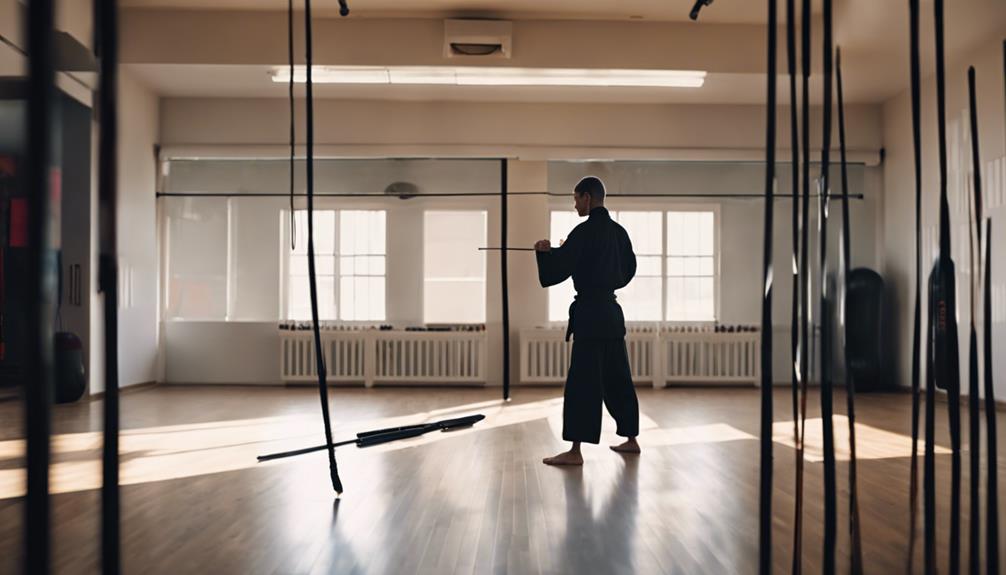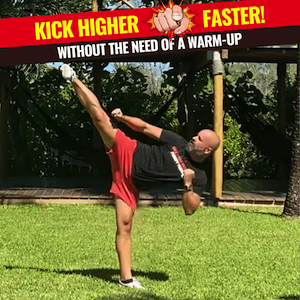When training in martial arts with chronic back pain, you must modify your techniques to minimize the risk of exacerbating discomfort and injury. High-impact martial arts can trigger or worsen back pain, and incorporating exercises that improve flexibility and core strength is vital for spine support. To create a safe training environment, discuss specific needs with instructors, incorporate low-impact exercises, and gradually increase training intensity and volume. Proper posture, smooth shifts, and continuous movement are essential in reducing weight loading on the spine, and making tailored adjustments will allow you to learn more effective strategies for long-term success.
Key Points
- Modifying martial arts techniques reduces back pain risks by minimizing jarring impacts and weight loading on the spine.
- Modified practices focus on core strength development to provide stability and support for the lower back.
- Low-impact martial arts styles like Tai Chi promote flexibility and reduce stress on the back during practice.
- Gradually increasing intensity and incorporating controlled breathing exercises help prevent injury and reduce pain.
- Consultation with healthcare professionals and experienced instructors is essential for tailored adjustments and a supportive training environment.
Managing Training With Chronic Conditions
When managing training with chronic conditions like back pain, it's important to reassess your approach to martial arts.
Certain movements can exacerbate discomfort and lead to further injury, particularly those involving sharp stops and hip rotation.
To mitigate this, it's necessary to incorporate exercises that enhance flexibility and core strength, which are essential for supporting the spine and alleviating chronic pain symptoms.
Engaging in low-impact activities, such as Tai Chi, can be particularly beneficial.
Adapting Techniques for Back Pain
Adapting your techniques can make all the difference in minimizing back pain during martial arts training. Modifying martial arts techniques can greatly reduce the risk of exacerbating low back pain by promoting proper posture and mechanics during training. This involves incorporating techniques that prevent jarring impacts on the back, such as looping movements like "Rounding the Corners."
This approach not only reduces back strain but also enhances striking power.
To further alleviate discomfort, focus on continuous movement during practice, rather than sharp stops. This minimizes weight loading on the spine, reducing the risk of exacerbating back pain.
It's crucial to make individualized adaptations, focusing on low-impact exercises and gradually increasing intensity to accommodate your personal comfort and pain levels. Consulting with instructors and experienced peers can provide valuable insights into modified techniques that maintain effectiveness while prioritizing back health.
Benefits of Modified Martial Arts
When you modify your martial arts training to accommodate chronic back pain, you can experience several key benefits that enhance your practice and overall well-being.
By incorporating techniques that strengthen your core, you can improve your stability and reduce your risk of back strain.
Modified martial arts training can also promote improved posture, allowing you to maintain proper alignment and minimize discomfort during practice.
Core Strength Benefits
Practicing modified martial arts can greatly enhance your core strength, an important factor in maintaining stability and support for the lumbar spine. By engaging in tailored exercises within martial arts, you can markedly improve the strength of abdominal and back muscles essential for maintaining proper posture. This, in turn, can reduce the risk of back pain exacerbation.
| Modified Martial Arts Techniques | Core Strength Benefits | Reducing Back Pain |
|---|---|---|
| Low-impact movements | Improved abdominal muscle strength | Reduced muscle strain on lumbar spine |
| Tai Chi-inspired routines | Increased back muscle endurance | Better balance and coordination to prevent falls |
| Controlled breathing exercises | Enhanced core stability | Improved posture to alleviate back pressure |
| Slow and controlled movements | Increased muscle hypertrophy for better spinal health | Reduced risk of further injury due to proper core strength |
Studies have shown that martial arts practices focused on core strength lead to muscle hypertrophy, resulting in improved spinal health and reduced pain incidence. Additionally, core strengthening exercises improve your balance and coordination, making you less likely to experience further injury from falls or missteps. This modified approach is vital in effectively reducing back pain through martial arts practices.
Reduced Back Strain
By focusing on core strength through modified martial arts techniques, you set the stage for reduced back strain and discomfort. Modified techniques can notably reduce back strain by emphasizing smooth, continuous movements that minimize jarring impacts on the spine, especially during striking and kicking. This approach helps prevent sudden stops that can lead to back injury. Incorporating loops in movements, such as "Rounding the Corners," maintains fluidity and alleviates discomfort.
Low-impact exercises and modifications in training can also alleviate discomfort while still allowing practitioners to engage in martial arts, ultimately promoting better spinal health. Research shows that martial arts practice enhances hydration levels in intervertebral discs, essential for reducing back pain and improving disc health.
Improved Posture
Proper alignment is the foundation of effective martial arts practice, and it's especially essential for individuals managing chronic back pain.
Modified martial arts practices emphasize proper alignment and mechanics, greatly improving posture by reinforcing core stability and reducing undue stress on the spine.
By engaging in modified martial arts, you can strengthen the muscles around your spine, leading to better support for your body's structure and a decrease in postural-related pain.
Regular practice has been shown to enhance body awareness, enabling you to recognize and correct your posture throughout daily activities.
Here are three ways modified martial arts can help you achieve improved posture:
- Reinforces core stability: Modified martial arts movements, such as those found in Tai Chi, promote core engagement, which is essential for maintaining proper posture.
- Reduces undue stress on the spine: Gentle, controlled motions in modified martial arts help counteract the effects of poor posture often seen in sedentary lifestyles.
- Enhances body awareness: Regular practice of modified martial arts enables you to recognize and correct your posture, leading to long-term benefits, including reduced back pain and enhanced functional mobility.
Creating a Safe Training Environment
When creating a safe training environment for martial arts with chronic back pain, you'll need to modify techniques to reduce strain on your back.
This involves discussing your specific needs with instructors to adjust movements and exercises that may exacerbate your condition.
Modifying Techniques Safely
Modifying techniques is essential to creating a safe training environment for martial artists with chronic back pain, as it can prevent exacerbation of symptoms by ensuring that movements don't cause strain or discomfort on the spine.
To modify techniques safely, you should consider the following adjustments to your training routine:
- Rounding the Corners: Adding loops to movements can reduce jarring impacts and enhance safety during striking. This technique can help minimize stress on your back while maintaining the effectiveness of your techniques.
- Continuous Movement: Minimize weight loading on your back by incorporating continuous movement during training. This approach promotes better mechanics and posture, essential for pain management.
- Low-Impact Exercises: Engage in low-impact exercises, like Tai Chi or gentle stretching, to maintain fitness without aggravating back pain. These exercises support a safe training environment and can help strengthen your core.
Regular posture checks and consultations with instructors or experienced peers can lead to effective modifications tailored to your individual comfort levels and pain management needs.
Reducing Back Strain
Reducing back strain in martial arts training requires a multifaceted approach that incorporates various techniques to create a safe training environment.
As you navigate your training with chronic back pain, it's important to take into account the impact of your practices on your lower back. Practicing Tai Chi, for instance, can enhance flexibility and reduce strain on your back during martial arts practice. This low-impact exercise promotes gentle movements that can help alleviate back pain.
To further reduce back strain, focus on developing a stronger core, which will provide additional support for your lower back. Regular posture checks during training are also vital, as poor posture can exacerbate back pain.
When executing striking movements, utilize the "Rounding the Corners" technique to minimize jarring impacts on your back. By incorporating these techniques into your training routine and gradually progressing in intensity, you can create a safe training environment that promotes recovery and minimizes discomfort.
Remember to consult with instructors and experienced peers to confirm you're managing your back pain effectively while still enjoying the benefits of martial arts training.
Overcoming Physical Limitations Safely

To continue practicing martial arts with chronic back pain, one must adopt a strategic approach that emphasizes safety and effective management of physical limitations.
Modifying your martial arts practice is vital to avoid exacerbating discomfort and preventing further injury. This can be achieved by incorporating low-impact techniques and focusing on form to protect the lumbar spine.
When overcoming physical limitations safely, consider the following key aspects:
- Strengthen the core: A strong core provides stability and support for the low back, reducing the risk of injury. Incorporate exercises that target your abdominal muscles and lower back.
- Progress gradually: Avoid sudden increases in training intensity and volume to prevent overexertion and manage pain effectively. Gradually increase your training load to allow your body to adapt.
- Consult healthcare professionals: Regular consultations enable tailored adjustments to your training routine that accommodate your physical limitations. This guarantees a safe and effective martial arts practice.
Sustaining a Healthy Martial Arts Practice
Building a stable martial arts foundation despite physical challenges entails safely identifying potential comfort risks associated with given martial techniques, consequently implying each skill entails additional exercises comprising many the myriad alternate for modification incorporation methodologies regarding teaching curriculum.
To sustain a healthy martial arts practice, consider modifying your techniques to reduce stress on your back. Low-impact martial arts styles, like Tai Chi, can be an excellent choice as they improve flexibility and core strength without placing undue stress on the back.
Techniques such as "Rounding the Corners" can enhance movement efficiency, reducing jarring impacts on the back while maintaining striking power. Regular posture checks and incorporating mobility exercises into your training routines can notably reduce the risk of chronic back pain.
Engage with your instructors and experienced peers to adapt your training to prioritize back health and overall safety. By modifying martial arts techniques, you can create a safe and effective practice that suits your needs and promotes long-term wellbeing.
In Summary
By modifying martial arts techniques to accommodate chronic back pain, you can maintain a safe and effective training regimen. This approach allows you to manage your condition while continuing to reap the physical and mental benefits of martial arts. By prioritizing adaptability and safety, you can sustain a healthy martial arts practice and overcome physical limitations without exacerbating your back pain.



